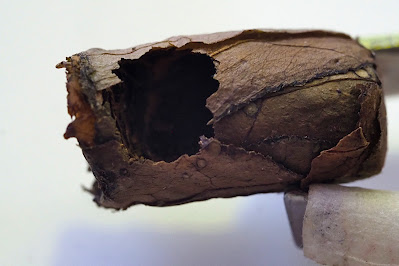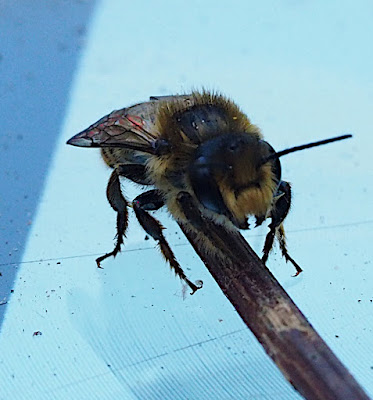Actually the correct term is "eclose"
Either way, its an interesting time.
And we've tried to capture a few photos & record some basic data.
In the last week of July last year, a female leafcutter bee (...or maybe 'bees') laid eggs and sealed them in 2 of the 8mm channels and 1 of the 10mm channels in our RSPB bee box.
In October I removed the 3 leaf wrapped 'columns' and separated them into individual cells (basically cocoons, but still with a leaf wrap).
These were kept in our store (...what used to be an integral garage, now truncated to a small space, just over 2 x 1m).
Because I couldn't be sure what type of solitary bee cocoons we really had, I didn't know when they would emerge. I knew mason bees emerge in March, so that's when I moved them to our outside covered wood-store. As they were in a jam jar with a small hole in the top, they could let themselves out!
I had been checking regularly on their progress during the months that followed, but in July, with the anniversary coming up, I was trying to check at least every other day.
I think I was lucky and saw the first bee emerge on the 12th July, but by the 15th, I found two more empty cocoons, which I believe emerged on the 14th.
I plotted a daily count of bees when they emerged...
...and for most I recorded the hour they emerged...
...notice that there is a clear preference for emerging in the morning. Also, the days are long in July here, where the sun rises just after 5am and sets around 9pm. So they didn't make full use of the available daylight, but must have a pretty good body clock nonetheless, by their apparent ability to pick the date & time.
what kind of bee?
They are leefcutters, which I initially thought could be Megachile willughbiella, a very common species. But our bees lack the very hairy front legs shown in the photos on NatureSpot here: https://www.naturespot.org/species/leafcutter-bee
They are also around 10-12mm in length, rather than the 12-18mm quoted by Nature Spot (...although I think this may be wrong, as other sources say 9-12mm).
After looking at photos by Steven Falk on Flickr, I've decided they are probably Megachile centuncularis, the patchwork leafcutter bee.
 |
| The males have a rounded rear compared to the females more pointed appearance. |
Most of our bees have emerged from the end of their cocoon, but a few have cut a hole in the side.
 |
| eye-to-eye with a leafcutter bee! |
If left in the bee box, they would all have had to escape via the cocoon ends (passing through other cocoons on the way out) as the sides would have been blocked by the box channels.
Sitting in our quiet study, the cutting noise is loud enough to be heard & recorded.
From this photo you can see that each bee is well equipped to cut their way out, and the female will go on to use their 'cutters' to cut and prepare leaves when laying eggs & sealing them up in a nest.
I was intigued by these small pellets on the side of the cocoon, which I estimate (by scale) to be approx 0.3 x 0.6mm...
...As they are between the cocoon casing and the leaf covering, I assume they are grub (larvae) excreta.
At the time of writing, we still have 10 cocoons that have not 'hatched'. Its likely that these have not survived, but possible that they may emerge later. I say this because I think there were 10 cells in one of the partially filled slots in the box; could it be that they were laid by a different female to the others? I think that if they have not emerged by early August, it probably means they were not successful.
However, I don't fully understand the lifecycle timings, so maybe August is still an OK month for them to breed and lay eggs.
From what I've read, the males emerge first and look for females. After they mate, the males soon die while the females live on for a few weeks and lay eggs.
It all seems a bit pointless!
questions, questions, questions!
There are things I don't understand, and I need more data!
- Its said that the females can control the gender of eggs laid. As the males need to emerge first and be ready to mate as soon as the females emerge, the parent female first lays a series of eggs in a tube which will become females and then eggs that will become males. So I'd like to know if this is always true or just generally true.
- What ratio of male/female eggs does she lay?
- Do the bees emerge in order? I can't see how this could be guaranteed. And if a bee way down the queue is ready to emerge before the ones in front, what happens?
- In the dark, in a horizontal tube, how do the eggs develop so that the bees are all facing the exit end of the tube?
I guess there is a scientific paper on this stuff somewhere, but where?
But I need to satisfy my own curiosity. So if we are lucky enough to get a few tubes filled with leafcutters this summer, I need to take a different approach in preparation for next year.
Maybe I need duplicate bee box draw channels in an over-winter holding box so I can preserve the order of the cocoons, and lay clear acrylic on the top so I can monitor what's happening!
Maybe something like this...
A few more pics
A very neat package...
A newly emerged male...
Bee #8 cutting its way out...
...the feelers are still folded back, but visible.
This one needs to clean its face, but feelers & cutting jaws are visible...












Hi Steve, I was reading your articles on the BirdnetPi and stumbled on this one. Maybe I can help give some answers. I own a guide on (Dutch) wild bees and it tells me that:
ReplyDelete* Yes, generally the first bees to hatch are the males. The only reason these males exist is for mating, so it is beneficial that they are ready to mate when the females hatch. This means that the brood cells (cocoons?) that contain males are on the outer edge of the tube. These are also the most risky cells because are more prone to be eaten by birds (woodpeckers) or taken over by parasites (Gasteruption wasps)
* The ratio of females to males in wild bees "is close to 1:1"
* Yes, the bees have to hatch in order. Actually, a lot of bees spent the winter as an "adult", just waiting to hatch. This differs between species: some winter as a larva, some as a (pre-)pupa and others as adults. It is no problem for them to wait until they can emerge. Apparently the hatching time is influenced by temperature and other environmental cues. But I have no clue how they know when they are next in line :)
* I have no clue how the bees orientate themselves. Maybe they just move towards that warmth/light of the sun?
Anyway, I enjoyed your blogs! Hope this gave you some answers.
Hi Barry & thanks for the information.
DeleteI read recently that in some bee species, a few bees don't emerge in the first year but stay in the cocoon for a second season. As I have a few non-hatchers from this year, I've now put them in a safe place, just in case!
Interesting, never heard about that before!
Delete